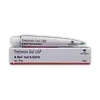What's inside
What's inside
 Key Ingredients
Key Ingredients

 Benefits
Benefits

 Concerns
Concerns

 Ingredients Side-by-side
Ingredients Side-by-side

Tretinoin 0.018%
Skin ConditioningNiacinamide 4%
SmoothingBHT
AntioxidantC12-15 Alkyl Benzoate
AntimicrobialCaprylic/Capric Triglyceride
MaskingCetyl Alcohol
EmollientEthylhexylglycerin
Skin ConditioningGlycerin
HumectantGlyceryl Stearate
EmollientHydroxyethyl Acrylate/Sodium Acryloyldimethyl Taurate Copolymer
Emulsion StabilisingOlea Europaea Fruit Oil
MaskingOleic Acid
EmollientPEG-100 Stearate
Phenoxyethanol
PreservativeDimethicone
EmollientWater
Skin ConditioningPropylene Glycol
HumectantStearic Acid
CleansingTriethanolamine
BufferingTocopherol
AntioxidantTretinoin 0.018%, Niacinamide 4%, BHT, C12-15 Alkyl Benzoate, Caprylic/Capric Triglyceride, Cetyl Alcohol, Ethylhexylglycerin, Glycerin, Glyceryl Stearate, Hydroxyethyl Acrylate/Sodium Acryloyldimethyl Taurate Copolymer, Olea Europaea Fruit Oil, Oleic Acid, PEG-100 Stearate, Phenoxyethanol, Dimethicone, Water, Propylene Glycol, Stearic Acid, Triethanolamine, Tocopherol
 Reviews
Reviews

Ingredients Explained
These ingredients are found in both products.
Ingredients higher up in an ingredient list are typically present in a larger amount.
This ingredient is an emollient, solvent, and texture enhancer. It is considered a skin-softener by helping the skin prevent moisture loss.
It helps thicken a product's formula and makes it easier to spread by dissolving clumping compounds.
Caprylic Triglyceride is made by combining glycerin with coconut oil, forming a clear liquid.
While there is an assumption Caprylic Triglyceride can clog pores due to it being derived from coconut oil, there is no research supporting this.
Learn more about Caprylic/Capric TriglyceridePropylene Glycol is an odorless, colorless liquid. As a humectant, it helps skin retain moisture. It also aids in delivering active ingredients.
Another role of this ingredient is preventing a product from melting or freezing. Propylene glycol also adds antimicrobrial properties to a product, elongating product lifespan.
This ingredient is considered an organic alcohol and commonly added into both cosmetics and foods.
Those with sensitive skin or conditions may develop a rash when using this ingredient.
Learn more about Propylene GlycolTriethanolamine is an emulsifier and pH adjuster. It is created using ethylene oxide and ammonia. This gives Triethanolamine a nitrogen core and a similar scent to ammonia.
As an emulsifier, it prevents ingredients from separating and enhances texture by adding volume to a product.
PH adjusters are common in cosmetic products. The pH of a product can affect the effectiveness of other ingredients. A product with a high pH may also irritate the skin.
Learn more about TriethanolamineWater. It's the most common cosmetic ingredient of all. You'll usually see it at the top of ingredient lists, meaning that it makes up the largest part of the product.
So why is it so popular? Water most often acts as a solvent - this means that it helps dissolve other ingredients into the formulation.
You'll also recognize water as that liquid we all need to stay alive. If you see this, drink a glass of water. Stay hydrated!
Learn more about WaterTretinoin is the best retinoid due to its proven skin benefits. It only available with a prescription in many countries.
All retinoids goes through a conversion line until it can become effective. The final step of conversion is retinoic acid; retinoic acid IS Tretinoin.
This is why tretinoin is so effective; it gets to work immediately on the skin.
Research on tretinoin has found it to be incredibly effective for reducing the signs of aging. It helps improve damage from the sun, even the skin tone, and smooth out wrinkles. It is also an effective acne treatment by reducing and balancing out sebum production in pores.
Tretinoin, like other forms of Vitamin A, increases the turnover cycle of skin cells. This helps the skin create newer and healthier skin cells faster.
It can cause irritation, redness, and dry skin because it is considered a "strong" ingredient. Those with sensitive skin should consult a professional about using tretinoin.
Using retinoids will increase sun-sensitivity in the first few weeks of use. Though studies show retinoids increase your skin's natural SPF with continuous use, it is best to always wear sunscreen and sun-protection.
Read about a form of retinoid you can purchase at the store, retinol.
Learn more about Tretinoin